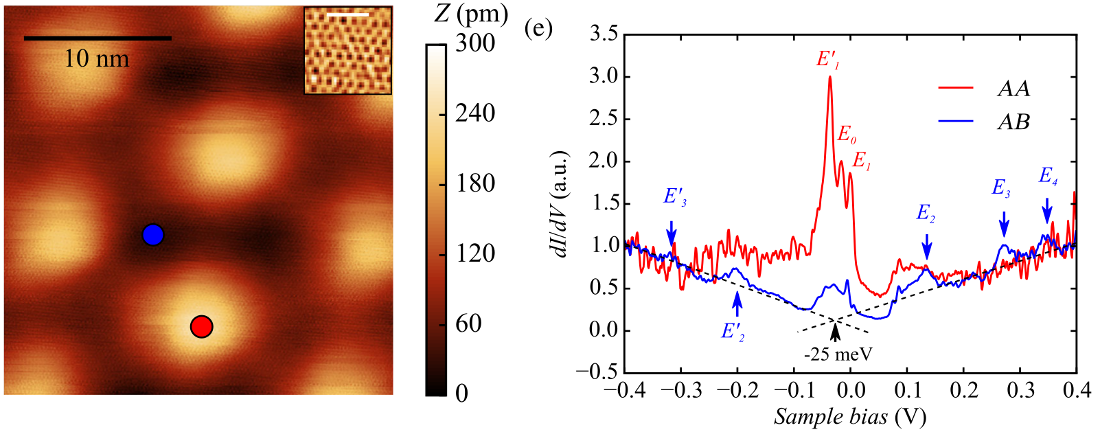PhD in heterostrain physics in twisted graphene layers
Master's training starting in spring 2019 (position filled).
We are looking for a motivated candidate for a PhD project preceded by a master’s training on heterostrain in twisted graphene layers. A moiré appears in twisted graphene layers which results from the superposition of the two atomic lattices with a rotation angle (See figure below). The resulting moiré potential has been shown to lead to a pletora of new physical phenomena. From van Hove singulatities which energy is tunable by the twist angle
[1], to electron localization by the moiré potential
[2] and the creation of topologically protected one-dimensional states in systems with very low rotation angle
[3]. Year 2018, was very fruitful for this system with the report of three important results : -Superconductivity was demonstrated to emerge in twisted graphene layers when the rotation angle is carefully adjusted to a precise ‘magic’ value
[4]. -The system was reported to be a quasi-cristal (system with rotational symetry but no translationnal symmetry) when the rotation angle is 30°
[5] -The electronic properties of the system were shown to be determined not only by the rotation angle between the layers but also by relative deformations of the layers: heterostrain
[6]. This last discovery was made in our group using a formalism developed by a former PhD student to quantify heterostrain and performing scanning tunneling microscopy measurements on samples where the heterostrain was native (resulting from the growth). While these have opened a new area of research by demonstrating the impact of heterostrain we have at present no control of this parameter. The Phd project therefore aims at developing ways to control heterostrain to be able to study its influence on the electronic properties by low temperature STM and possibly discover new states of matter. The attendee will be involved at all steps: sample preparation, design and fabrication of the system allowing to tune heterostrain, STM measurements and analysis. The analysis will be done in collaboration with the Theoretical team of Cergy Pontoise which has a long experience in twisted graphene layers.

Fig.1 - Left, image of twisted graphene layers with a rotation angle of 1.2° between the layers. The intensity modulation superposed to the atomic lattice is a moiré resulting from the interference of the two atomic lattices. Right, local density of states measured from dI/dV spectroscopy performed in the STM at the position indicated by red and blue dots in the left panel. The resonances E1,E2, E3, E4 result from the peculiar arrangement in this system which is determined by rotation and relative deformations between the layers: heterostrain.
[1] G. Lucian
et al.
Nature Physics
6, 109 (2010)
[2] G. T. de Laissardière
et al.
Nanoletters
10, 804 (2010)
[3] S. Huang
et al.
Phys. Rev. Lett.
121, 037702 (2018)
[4] Y. Cao
et al.
Nature
556, 43 (2018)
[5] S. J. Ahn
et al.
Science
361, 782 (2018)
[6] L. Huder
et al.
Phys. Rev. Lett.
120, 156405 (2018)